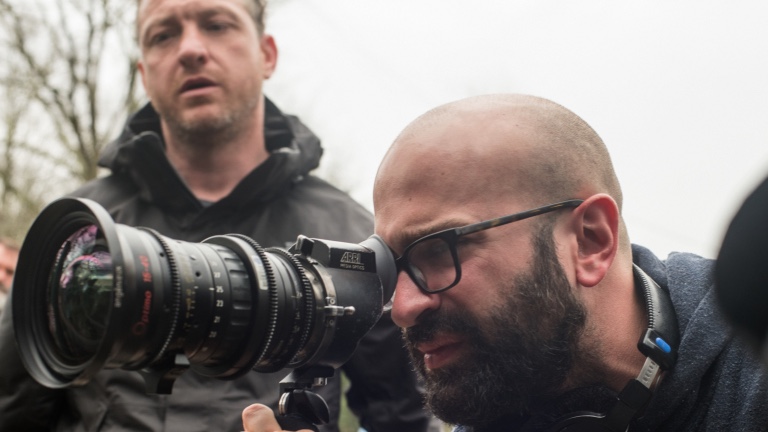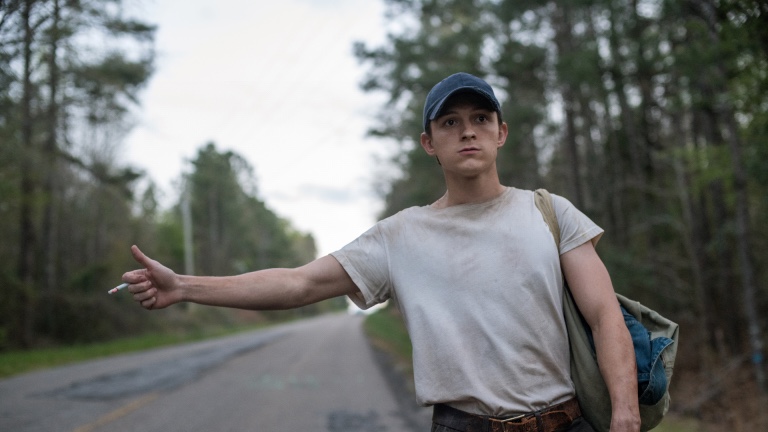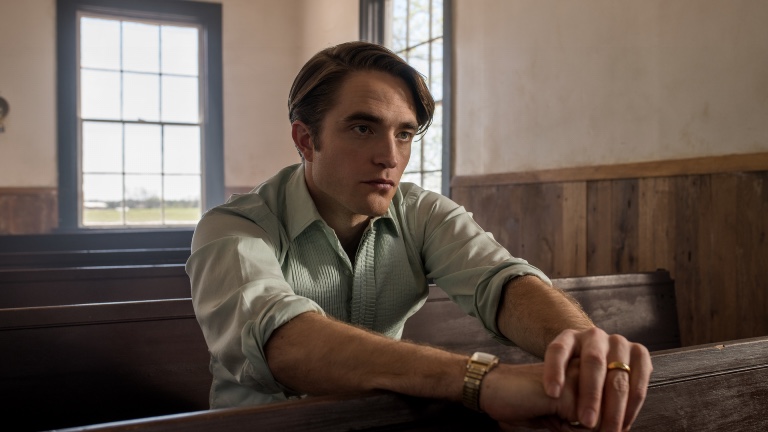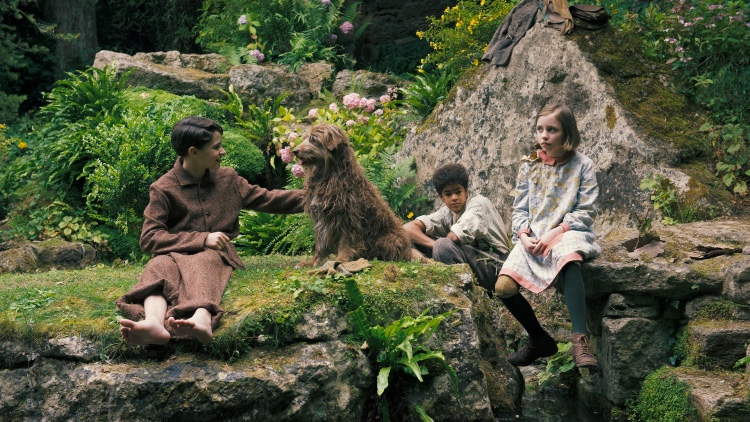There’s no question that part of what makes Antonio Campos’ The Devil All the Time (now streaming on Netflix) so compelling is that like many of the filmmakers’ other films, it has such an amazing look that really makes the Appalachian locations jump off the screen.
It’s partially due to the capable eye of Cinematographer Lol Crawley, whose very first feature credit was Lance Bass’ Ballast, which premiered at the Sundance Film Festival in 2008 and received an Excellence in Cinematography prize, as well as an Independent Spirit Award nomination the following year. Crawley would return to Sundance with Chris Morris’ Four Lions in 2010 before working with two filmmakers who would become regular collaborators.
Crawley’s work with director Marc Munden’s adaptation of The Crimson Petal and the White would lead to a BAFTA TV nomination, and then Crawley would shoot actor Brady Corbet’s debut feature, The Childhood of the Leader, the latter receiving praise at the 72nd Venice Film Festival and a second Indie Spirit nomination for Crawley. Crawley would reunite with Munden for The Secret Garden, released over the summer, and with Corbet for his second feature, Vox Lux, starring Natalie Portman. Crawley also collaborated with director Andrew Haigh for his well-received second feature, 45 Years, in 2015.
Crawley’s work with Antonio Campos is likely to get just as much attention because it adds to the stark nature of the story being told about multiple generations of men in Southern Ohio who must deal with the despicable people living in the town. It stars Tom Holland, Robert Pattinson, Bill Skarsgård, Jason Clarke, Riley Keough, Haley Bennett, Sebastian Stan and many more, a true ensemble thriller that’s adapted from the award-winning book from Donald Ray Pollock.

Below the Line spoke with Mr. Crawley a few weeks back for the following interview.
Below the Line: I know you also shot Secret Garden as well, so did you have a break in between or did you do them back-to-back, because that might be the strangest tonal change in movies between them.
Crawley: No, there was a bit of a break in between. I actually ended up doing Secret Garden straight after a movie called Vox Lux, which was actually where I last saw Antonio before doing the movie. There was a break in between, but yeah, quite a contrast.
BTL: Vox Lux was directed by Brady Corbet, who had starred in one of Antonio’s earlier films.
Crawley: They all used to be part of the same sort of filmmaking, Borderline, so I guess that’s how I was introduced to Antonio.
BTL: So how did Brady first come across you to shoot his film?
Crawley: With Brady, I shot his first film, The Childhood of a Leader, which was going back to 2014 maybe now, something like that, so I did that and Vox Lux, and then working with Antonio.
BTL: What were your first conversations with Antonio like? Did you read the original book before taking this on or the script?
Crawley: No, by the time it came to me, the script was fully formed, so I sort of read the book in retrospect, but it was definitely the script I read first that appealed to me.

BTL: I assume that almost all of the film is location-based.
Crawley: It was. I would say 85 to 90%, and then at the end, there was like a week in a studio where we just built the upstairs of Willard and Charlotte’s house when she’s getting sicker, and then little Arvin eats the pie. The upstairs two bedrooms, that was built, but that was really the only set that we had. That was the last week.
BTL: A movie like this where you do have so many locations, are you involved in the location scouts in pre-production and finding what you have for natural lighting and such?
Crawley: A lot of the pre-production on this one. I don’t remember the exact number locations, but for this, a large amount of the pre-production was involved in really finding the location. So we were like scouting for weeks on end trying to find everything. Eventually, we found it but it’s hard to find that many locations that can still pass for the ‘50s and ‘60s and have everything you need. It takes a long time to get all that together.
BTL: I’m curious how you dealt with the natural lighting, because when you find a location, you can’t just stay there from morning to night to see what the best time and place to shoot it, so does that come from instinct or are you at these locations long enough that you can find the best time to shoot there?
Crawley: Yeah, it’s tricky, especially when you’ve got these exterior locations, and you’re trying to get continuity of light to make it seem like it took place over an hour or so, and then maybe filming them over two days. Maybe you end up coming back and having to do pickups or additional shots that you couldn’t get at the time. One location in mind is the church where Harry Melling’s character pours spiders all over himself. That whole scene was shot during the one day, but it’s supposed to be a service that maybe lasts an hour. Even though that’s an interior location, you’ve got so many windows, it’s almost like in an exterior location in that it’s very hard to light into it without seeing all of the stands or the lifts or all of those things. Obviously, by the end of the day, you’d have this kind of warm magic hour sun coming in that is very different in terms of its direction and color. All the time, you’re trying to wrestle those things and make sure that some sort of continuity, and those are the most challenging aspects.
BTL: Were a lot of those locations fairly nearby to each other or were they literally all over the place?
Crawley: No, I think, they were pretty disparate in their geographical locations. It was tough, because that also eats into the amount of time you have in the day to shoot, when you have to travel. That is difficult. They were spread out over quite a large area.
BTWL: Does Antonio use a lot of reference when you first meet with him, whether it’s other films or paintings or pictures to capture the look and feel of what he’s going for, or is a lot of that more dependent on the locations?
Crawley: Everything, ultimately, is informed by the locations and the shot listing, so then the hope or the intention is that by the time you come to shoot, you’ve created something that’s influenced by other works, but doesn’t have too obvious a debt to those ones. We looked at films like Night of the Hunter, and The Godfather is a favorite of Antonio’s in terms of the mood and tone of some of the domestic situations that influenced us. I really like The Beguiled, the Sofia Coppola remake. I think a big sort of reference point early on were the documentarian photographers of America in the ‘40s and ‘50s, like Dorothea Lange, Walker Evans, Robert Frank, those black and white photographs essentially of Americans on the breadline, those wonderful photos. They provided the inspiration and point of reference for all the heads of department really, certainly for the rural community and Emma’s house, Willard’s mother, and in the church scenes and things like that. Then we really contrasted, influenced by the rise of color photography, like William Eggleston and photographers like that. I think we really wanted these two worlds where the rural communities felt more like an Andrew Wyeth painting, and they felt sort of timeless. Even now, certainly in the UK or in America, when you go to rural communities, they feel like they just operate on a different sense of time. They’re slower to catch up. It’s different when you compare that to the cities, and I think that’s what we were trying to do was really come up with a a color palette and a tone and an approach that would contrast the 40s with the 60s but also the rural environments with some of the towns that we were filming.

BTL: And you’re shooting all of this on film?
Crawley: Yeah, we shot the whole thing on 35mm code, which no doubt was the right approach. I prefer it as a medium most of the time anyway, and especially for shooting a period piece. It has a quality that’s not striving to show the most definition, not trying to show every single pore. It’s not trying to show every single thread of fabric. It’s a technology that is used to create a more painterly impression and feel of a place, as opposed to 100% how much clarity can we get into this image?
BTL: I feel that a lot of film critics and just people in general don’t have a good reference point to talk about cinematography, because it seems like such a different language, and the way you described these paintings, it created the visuals.
Crawley: I always think it’s important to state that with photography, there’s always this sense of a celebration of the strength of the blacks. They always talk about how strong the blacks are in a photographic image and how rich the blacks are. I actually conversely, think that with painting, you rarely use black in its truest form. If you’re building up a shadow, then you build it up through purples and browns and these different colors that exist, and it’s obviously very, very dark, but there is color in there. I’m sort of more intrigued by trying to push a color into the shadows. I’m trying to use painting as a reference as opposed to photography to inform cinematography. Does that make sense?
BTL: It’s interesting how you talk about the focus on the blacks in photography, because just by the lack of open movie theaters, I’m watching a lot more movies on my laptop, and I’ve noticed that a lot of recent movies that has a lot of nighttime filming, it’s very hard to see what’s going on because the screen is almost entirely black.
Crawley: No, I know. I’m watching stuff on Netflix or other platforms. The problem is that the way that a lot of people shoot and increasingly shooting dark scenes, which I think is great, and it is legitimate. If you’re in a bright room, it’s often hard to see enough detail to be able to see what’s going on, so I think that that means that photography is forcing people to not be as brave in their photography. I also think you go to the cinema to have your attention focused, and to be in a room with all the sort of distractions you have, living in your house, your sense of concentration, it’s a lot harder, rather than being wedged between two strangers in a dark space, which automatically focuses you to not be squirming around in your seat and looking at your phone every two minutes.
BTL: All of Antonio’s films have looked very different and this is no exception. Is he very meticulous about storyboarding and creating shot lists, just really sitting down and preparing in advance? Or is there still room to change stuff when you’re filming?
Crawley: There’s always a lot of room to change to change stuff coming from Antonio. The thing is that once the schedule is set, you don’t have a lot of room to just completely throw everything out and then find it on the set, in the moment, although there are often happy accidents and things that happen. There was less storyboarding with this, it was more sort of shot-listing — we heavily shot-listed, which was sort of invaluable really. There were certain things we were trying to do, like there’s a certain language when you’re trying to ramp up the drama or the thriller elements, there’s a way of constructing things that that relies on having the right shots to be able to construct that. You really have to think about these things carefully. I think if you’re trying to really build tension in a scene, and you haven’t really given a lot of thought beforehand, than you just see the scene being rehearsed and then decide to shoot it. There’s a very strong chance that you won’t have all the elements you need.
There was a movie Ballast, the first film I shot, there was very much “Let’s see the scene and just respond to it,” but the whole esthetic of that movie and tone of it was much more like a documentary. There was the necessity to ramp up tension in a thriller way. That ramping up of tension has to absolutely be informed by the correct language and how you move the camera, how you light it and how you place it. They’re not necessarily innate. It’s a learned language and a learned skill and like any language, you have to spend time studying it and understanding it, which is the process of shot-listing really.

BTL: I do want to ask about Secret Garden because that film looks absolutely amazing, and it’s such a contrast to the movie you made with Antonio, but I still have no idea if that was a real garden or something constructed in visual FX, because it looked so gorgeous. Can you shed some light on that?
Crawley: Secret Garden was shot over about five different gardens in the UK from Yorkshire down to the gardens of Cornwall and Dorset. Obviously, the whole garden is a fantastical, boundless take on the Secret Garden. It doesn’t have the traditional four walls of an English garden, therefore, we were free to explore, and the whole garden was stitched together out of about five or six different gardens, and then the whole interior of the house was built on a stage and then we used some real locations but most of the house was built on a stage.
BTL: We’re obviously in a bit of a down time right now. Have you been able to use this time to prep for anything else?
Crawley: Well, I graded two films. I did the color timing on Devil All the Time, but also on a film called The Humans, that was a Tony-winning play that Stephen Karam wrote, and we actually shot that in New York a year ago, and I’ve been using my time to color time that, and then I’m just now reading scripts again and currently shooting a commercial.
BTL: Are you able to do color-timing at home somehow or do you still have to go to a studio?
Crawley: Both movies, they’ve been remote sessions, which basically means I’m in Techicolor L.A. while Antonio is in Technicolor New York, and then the other version is that you’re given a calibrated iPad, so that I can be at home and see what’s happening on an iPad.
The Devil All the Time is now streaming on Netflix, and you can read more about the film in our interview with Antonio Campos.





